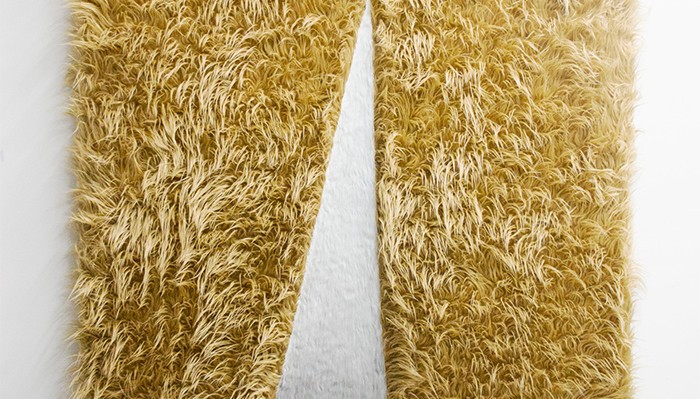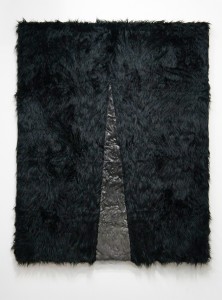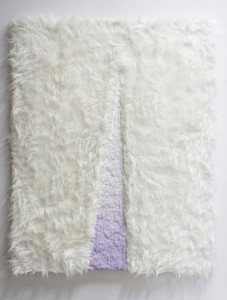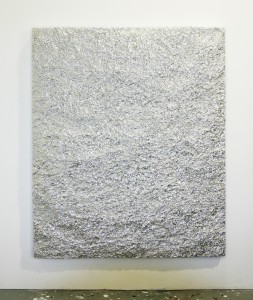
8.13.13 Interview with Wayne Adams by Pooja Kakar
Brooklyn-based artist Wayne Adams seeks to explore the unknown through his use of alternative media such as faux-fur and aluminum foil. The interplay between these media and their surrounding environments create a purposeful void in his works and an emotional and intellectual experience for the viewer, that facilitates conversations on reality and religion. His recent participation in the “Works Off Canvas” exhibition at the Denny Gallery showcases his use of these different media as an alternative to canvas, and spotlights the role of the medium itself in a work of art. The unique quality and perplexing meaning behind Adams’ work inspired this interview in order to learn more about him and the process behind his work.
Pooja Kakar: For the “Works off Canvas” show, what was the significance behind using fur? What drew you to that medium?
Wayne Adams: First, it’s always faux-fur. I haven’t tried painting on real animal fur at this point and don’t know if I ever would—possibly, but not now. Faux-fur seemed completely wrong and impossible to paint on, especially with straight lines. This is what initially drew me to it. It started as an accident; I picked up a bag of faux-fur that someone in my studio building was throwing out. When I finally stretched it like a canvas, I knew I needed to paint something on it. There’s something perverse and futile about it, which reminded me somewhat of the pursuit of being an artist, specifically a painter. What could be more ridiculous? So I decided to try one ridiculous act in order to understand another.
PK: Could you explain your process?
WA: Most simply, the faux-fur is stretched over a conventional wooden stretcher, very similar to stretching a canvas. Once stretched, there is a process of brushing/matting down the fur to sketch out the shape that will be painted onto the fur. Once the right shape for the piece is determined, I tape the sides and basically cake on as much gesso as necessary to hold down the texture of the fur, and then work on creating a fade of color to create a sense of space or depth within the shape.
PK: Could you explain the intended effect of pairing the fur that is raised with the fur that is matted down?
WA: The faux-fur pieces have been described as being very theatrical, and I rather like that characterization. There’s a sense that the triangular shape creates a space within the plane of the faux-fur. Conceptually, it started to gain further traction for me when I was reading a book by Slavoj Žižek, where he was referencing Courbet and Malevich and the impossibility of depicting the Thing—which, in my tradition, I would call God. So he argues that it would be impossible to paint an image of God, but what would be possible is to paint God’s absence—a void that calls for the existence of God. So, in some sense, I see the painted spaces as voids. In another sense, they seem to work as ‘rifts’ or breaks in the picture plane which, in this case, is what’s more familiar as an actual picture or image (the part with paint). I like the idea of the painted part becoming the most real part of the work.
PK: In what ways, if any, are the pieces for the “Works off Canvas” show different from your previous works?
WA: This is a relatively new series for me, so it’s not so much of a departure for this show as it is somewhat of a new presentation of this body of work.
PK: What are you currently working on?
WA: There are more faux-fur pieces in the works, on larger and smaller scales. I feel like there’s a lot of territory to explore and am pretty excited about diving into it. I’ve also revised an older series of works where I’ve stretched large sheets of crumpled aluminum foil in a similar fashion, except without the paint (at this point). More ‘traditional’ paintings people would be familiar with from my past work are also coming along.
PK: There seems to be a religious undertone to the titles of some of your works, for instance: “Doubt and Belief” and “A Community of Believers.” Could you explain the significance of these titles?
WA: This is definitely intentional, but I don’t want to force people into a conversation that seems overly narrow or didactic. Titles are a way to frame a work between certain conceptual parameters. When I finish making something, I look for ways that a title might help someone access an idea I might be trying to address or process in the work. For instance, with “A Community of Believers”- I like that the possibility exists for the triangle shapes to be read as portraits or related parts of a whole—like a community. Why “believers”? Western, Protestant Church is a strange and interesting thing to me—it’s performative and mystical, and at the time of that particular painting, I was thinking about it quite a bit. I’m learning more and more to see each individual work as part of a larger, connected conversation. Religion seems to be a regular part it. Part of the reason is because of my upbringing in the Midwest with a very enthusiastic, church-going family. Part of it is also because religion is still very much a part of my life and is such a significant cultural conversation—both in the US and worldwide. I see quite a few artists addressing it, but not so much conversation happening on an institutional (gallery/museum) level.
PK: You’ve experimented with different mediums such as fur and foil, what drew you to these materials in particular?
WA: It all originated with a series of paintings I was making of things that reflected or emitted light. Tinfoil just clicked as this great material for me to continue that line of thinking, whether I was using it directly or making paintings of it (which I still do, off and on). Maybe it’s just my own short attention span or something, but I like the physicality of the fur and foil works and how they contrast the paintings on canvas. Maybe “contrast” isn’t the right word…maybe “complicate” works better.
PK: The foil works, “The Body of Christ” and “An Unceasing Revelation of Divine Light”, are really interesting due to their abstract nature and religious titles; could you explain the inspiration behind these pieces?
WA: I’m actually looking for a way into a personal type of abstraction—mainly through painting, or at least a painting frame of reference. So I look for ways that ideas or aspects of my life can connect with what I’m interested in making with my hands.
Regarding the titles, there’s a verse in the New Testament of the Bible in which part of it reads, “God is light and in him there is no darkness at all.” Tinfoil works as a vehicle for thinking about this idea of God as light—actually looking at something that emits and reflects light. Additionally, the idea of Christians (although this could apply to people in many religions) attempting to reflect the nature of God in their lives is interesting from the same God as-light perspective. Following that line of thinking, there is another biblical metaphor of Christians as “the body of Christ.” I like the way the physical material can be a catalyst for me to think about these things all at once—reflecting God, God as light, believers as part of God’s body. So as I look at the foil I see this material reflecting light in infinite ways. That’s interesting to me.
“An Unceasing Revelation of Divine Light” is a title that comes from Rabbi Abraham Joshua Heschel. His way of describing ideas of religion and God is highly poetic and I’ve found his teachings to resonate with my own interests and beliefs (although I don’t happen to be Jewish). I like how that title seems to fit with the physical nature and action of the aluminum foil—constantly revealing/reflecting (divine) light. That’s beautiful—and not in the cliché/pejorative sense.
Plus, the tinfoil is shiny, and pretty much looks super fantastic when I make large pieces out of it…so there’s that.
PK: What is your studio space like/ where do you get the inspiration for your work?
WA: First, my studio is pretty small, but close to my house (1/2 a block away) and big enough to at least get the job done. It’s around 200 square feet.
Second, Inspiration comes from a lot of places, but for a long time now, it’s come from religion (Western Christianity) and philosophy (from Kierkegaard to Žižek). I also see a lot of work, living in New York, and there’s probably a fair amount of responding to other artists and work that I like (or at least have a reaction to). It is my way of trying to participate in some of the ongoing conversations in the contemporary art world.
“Works off Canvas” at Denny Gallery closes on September 8, 2013. More information at dennygallery.com
Tags: Journal

